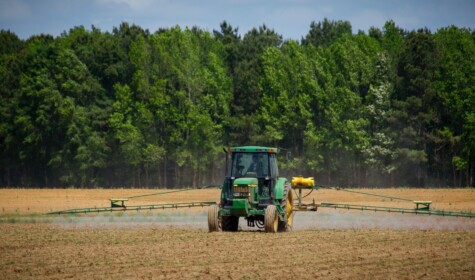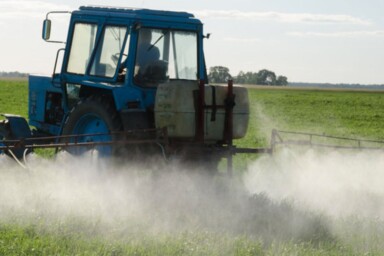Imagine you are a farmer planning your cropping for the next few years to ensure everything remains healthy, productive and, especially, weed free.
While you’re busy at this task, you read in a respected magazine that there is a new spray which you can apply liberally that will kill all plants, except those genetically engineered to be tolerant to it, without causing any negative side-effects whatsoever to the natural environment or human health. At the same time, the use of this spray will save you an extraordinary amount of time and money, deliver carbon benefits and bring countless other efficiencies, all at an affordable price.
If you were that farmer and had taken at face value the compelling, seemingly evidence-based, advocacy about this product’s safety and efficacy which, by the way, tens of thousands of UK farmers already have, you would probably go ahead and use it.
And, if then, having incorporated it into the heart of your farming practice, some environmentalist troublemakers started concerns about potentially harmful and undesirable impacts upon the environment and human health, you might well lobby your farmers union to go on the offensive by highlighting the lack of conclusive evidence linking the product to negative health and environmental outcomes. This is exactly what has happened with a herbicide based on glyphosate, a chemical which, when mixed with so-called adjuvants – compounds which make the glyphosate more ‘sticky’ – increases its potency by 100 times, making it remarkably effective.
When you think about it, and appreciate how difficult it can be for farmers to remove glyphosate from their current practice, it is hardly surprising that the National Farmers Union (NFU) has been campaigning strongly for the last few years to prevent its withdrawal. This is despite growing evidence of glyphosate’s harm throughout the world, which has led many countries in the European Union to consider banning its use.
Farmers in the UK and throughout the world, have developed an umbilical dependency on the use of Roundup and other glyphosate-based herbicides, so they are understandably anxious about any possible withdrawal by regulators. This dependency is directly related to the predominance of the continuous cropping systems that have become the norm during my farming lifetime, now spanning over 50 years.
Until the 1950s and 1960s, most farms had crop rotations with a fertility building phase, normally of grass and clover, which not only restored to the soil the carbon that was released during the arable phase of the rotation, but also reduced weed populations. With the virtual disappearance of such rotational systems, which have been replaced by continuous arable cropping, it has become almost impossible to avoid a build-up of previously controllable arable weeds. The consequence is an ever-increasing dependence on the chemical sprays that are seen as a godsend in the eyes of many farmers.
I have made it my business to pay attention to the gathering body of evidence calling into question the safety of Roundup and other glyphosate-based herbicides over the last 10 years. The first major challenge was posed by a French scientist, Professor Gilles-Eric Séralini, who undertook a scientifically impeccable study on rats, precisely mimicking the study that Monsanto had undertaken as a necessary prerequisite for obtaining the EU pesticide safety certificate.
Séralini’s study involved feeding rats on genetically modified corn and Roundup at the prescribed minimum levels of their drinking water, not just for 90 days, which is what the regulators require, but for the full lifetime study of two years. He did this because, as a scientist who had access to the data which Monsanto lodged in the annals of the European commission, he noted that, at the end of the 90-day Monsanto trial, some of the rats were showing kidney and liver irregularities. In his replicated but longer trial, to his consternation, he observed that many of the female rats went on to develop mammary tumours and that kidney and liver irregularities worsened as the trial progressed.
Séralini was determined to publish and promote awareness of the data arising from this trial as widely as possible, but during the run-up to its launch the pesticide industry got wind of his intentions and organised a brilliant counter campaign, the result of which was to discredit Séralini as a scientist as well as to call into question the adequacy of the design of his study. This all took place in 2012 and, although the Sustainable Food Trust did its best to stand behind Séralini’s evidence, organising a press conference in London and speaking publicly about our conviction that the study was in fact well designed, the counter campaign undertaken by industry bodies was largely successful. As a result, it became unwise in journalistic circles to give any credence to Séralini’s study.
Fast forward another 10 years and there is a growing body of research suggesting that the use of Roundup poses long-term threats not just to the environment and biodiversity but also to the soil microbiome and human health. Some studies have gone so far as to suggest that the rising prevalence of previously uncommon diseases, ranging from diabetes, obesity, cancers, food intolerances and diseases of the nervous system is, in part, related to the capacity of Roundup to interfere with the genetic pathways of bacteria. Whether or not Roundup is eventually shown to be a causal factor in the development of these diseases and conditions, this disturbing evidence should surely be taken seriously and prompt further research.
As this newsletter goes to press, despite the cumulative evidence of Roundup’s harmful effects on life, these findings are yet to be taken seriously by government. Such has been the success of the industry campaign that it is still regarded as unorthodox and fringe to side with people who consider Roundup and its use to be unsafe.
A parallel might be observed in the history of the use of tobacco. When I was young, despite the large body of evidence showing its dangers, I continued to smoke. Most of my generation ignored the calls for caution. I started smoking in my mid-teens and can still remember the guilty pleasure I experienced with smoking my first Players No6 in my bedroom! Although I never was a chain-smoker, I settled at one or two roll-ups a day in my early 20s and continued smoking into later decades until a dose of pneumonia brought that abruptly to an end around 2010. As I like to say to people, if you need to quit smoking, try contracting pneumonia – it works brilliantly and, as I reflect now, it is so often the case that dangerous substances or practices finally get their comeuppance through health shocks.
If we follow the trajectory of smoking’s demise and apply the same bell curve to the use Roundup, we are perhaps still some years from the moment when, eventually, the Government steps in and either bans its use or introduces a range of measures to ensure that we reach the end of the Roundup chapter of agricultural history.
In the meantime, if you live anywhere near a farmed landscape, farmers are likely spraying Roundup to kill off grassland pastures and weeds in cereal stubbles, to enable the use of minimum-till systems and, increasingly, as the so-called ‘pre-harvest desiccant’. This means that, a week or so before harvesting a crop of wheat, barley or other grain, farmers will spray the ripening field, both to kill off any grasses or weeds in the understory of the crop and to hasten the ripening of the grain, as well as speed up the drying process to enable faster combining.
The pervasiveness of these practices mean that many of us are getting a daily dose of Roundup in our food. This is especially true of bread in the UK, but if we look across the Atlantic to America, Roundup has been found in virtually all rivers and water systems, in the rain and air, and in human urine.
Should we be worried about this? In short, yes, and in response, we should be calling for further research to identify the potential risks. In the meantime, if you want to take action, consider buying organic to minimise your potential exposure to Roundup residues.
For more on Roundup and its use within different farming systems, click here for an in-depth article by SFT’s Policy Director, Richard Young.







